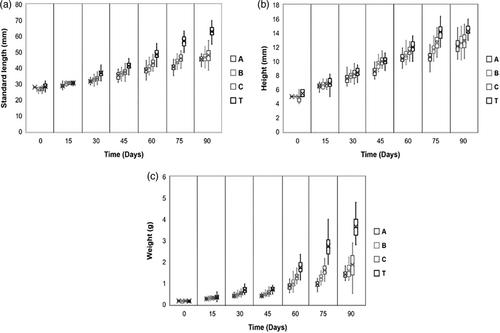Development of alternative feed with seed and insect meal for sustainable production of rainbow trout (Oncorhynchus mykiss) and quality fillets
Abstract
Background
Rainbow trout (Oncorhynchus mykiss) is a freshwater fish with an aquaculture industry widely distributed throughout the world, whose diet is based on fish meal (marine origin), with serious sustainability problems associated with the sector. The objective of the study was the inclusion of other flours as a protein source (insect and vegetable) to replace conventional diet for O. mykiss hatchlings. Feed with different protein contents (35%, 40%, and 45%) was used, therefore, with an insect meal content of 38%, 45%, and 53%, respectively, in order to maintain an isoenergetic balance. The quality analysis of the feed used was based on a proximal and amino acid analysis of the meals. For the evaluation of the alternative feed, 150 O. mykiss fry were used for 90 days, considering the increase in size (standard length) and weight every 15 days. The feed intake was 8% of the animal biomass, rationed four times a day. In order to analyze the quality of the fish fillets, 20 fish fed with each alternative feed were kept for a further 60 days.
Results
The substitution of fish meal by vegetable and insect meal allowed the biochemical profile that the conventional feed contains to feed O. mykiss hatchlings to be met. It was shown that, during the first 6 weeks, all alternative feeds and the conventional feed resulted in similar sizes and weights in the pups. However, at the end of the study (at 3 months), the conventional feed reported larger fish sizes and weights than the alternative feeds. On the other hand, these differences in growth did not impact the quality of the fillet for consumers.
Conclusion
The development of an alternative feed with 75% of other ingredients (fishmeal, chilacayota, corn and Tenebrio) was a feed with 35%–45% protein, necessary for the trout hatchlings to grow and produce a quality fillet. The study showed that reducing the consumption of conventional feed favors production costs for aquaculture centers, whose mission is to produce hatchlings and keep them for up to 2 months to be offered to fattening farms and promote sustainable production.






 求助内容:
求助内容: 应助结果提醒方式:
应助结果提醒方式:


